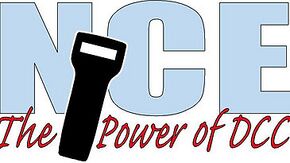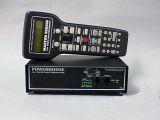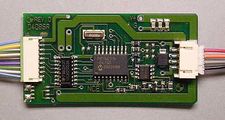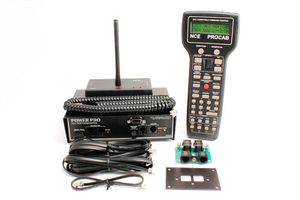NCE
Manufacturer: NCE
Summary: NCE began as an OEM in 1993, supplying hardware and software for the Wangrow SystemOne. NCE became a DCC manufacturer when Wangrow passed on the NCE Power House DCC system as the replacement for the SystemOne. Today NCE offers a variety of DCC Systems and accessories.
| See more Manufacturers | |
|---|---|

| |
| General information | |
| Phone | +1-585-265-0230 |
| Fax | +1-585-265-0234 |
| [email protected] | |
| CV8 ID# | |
| Main URL | Main URL |
| URL to manuals | |
| Address | NCE Corporation
82 East main Street Webster, NY 14580 |
| Date Opened | 1993 |
| Date Closed | |
| Successor | |
| Device Types | Booster, Command Station, Mobile Decoder, Other, Power Supply, Stationary Decoder, Throttle |
NCE Corporation
Company Summary
NCE Decoder
NCE began manufacturing DCC Products on an OEM basis in 1993 and was originally known as North Coast Engineering. They provided the software component of Wangrow's SystemOne and RamFixx Technologies' RamTraxx DCC systems. The name was changed to NCE when it was incorporated in 1996. Today, NCE has to grown into a full-time electronic design and manufacturing firm devoted entirely to the development and sale of products for the control of model railroads.
The NCE Power House was intended to be marketed by Wangrow as the next generation SystemOne. Wangrow declined, so NCE decided since it was a finished, ready for production product, they would release it under their own brand. Wangrow subsequently went out of business when their licence for the command station software supplied by NCE expired. Wangrow failed to comprehend the difficulty and time requirements needed to create their own software.
AML Interview with Jim Scorse of NCE
This is an audio podcast of an interview with Jim Scorse. Listen in the background if you wish. Youtube allows allows changing playback speed.
There are so many great folks to talk with in the AML Nation and one of the best, is our very own Jim Scorse the owner NCE. Jim has spent over twenty years building NCE into one of the most important companies in the hobby while he continues to innovate and improve his products year after year.
But like so many of our guests Jim isn’t just NCE, he’s passionate about model railroad operations along with his many outside interests such as trivia nights at the local pub, online racing, and his love of music. It’s a great interview and one we’re sure you’ll enjoy, so grab yourself a big bowl of shredded car cards, a steaming hot mug of melted solder and enjoy!!
Products
NCE produces a full line of Digital Command Control products
Starter Sets
Advanced Systems
- Power Pro
- Power Pro R (Radio)
- Power Pro 10
- Power Pro 10 R
Originally this system was marketed under the Power House name. Complete system with Throttle (Pro Cab), integrated Command Station / Booster. A Power Supply is NOT included.
- Five- and 10-Amp versions available.
- Walkaround capability
- Expansion: 63 devices (Additional cabs and accessory items). NCE calls anything on the throttle network a "cab".
- Interface: Serial Port, RS232. USB adaptor card is not recommended as some commands are not available over USB connections.
- Programming Track connections, Programming Track Booster recommended.
The radio systems will be upgraded and increase the number of channels available in the process. It will be backwards compatible. [1][2]
Entry Level Systems
- Power Cab
While the Power Cab looks a lot like a Power Pro (they use the same package for the throttle), it is a 1.5A Booster, Command Station and Throttle integrated into a handheld device. If you disconnect it from the layout, everything stops as the DCC track signal is generated in the handheld. Adding a Smart Booster eliminates that issue. The tight level of integration limits the available current for the track power bus. Some software features are also absent.
The Power Cab features Pro Cab compatibility when connected to NCE Pro Cab / Power Pro command station it functions as a throttle. A cable to enable this feature is included.
The interface to the layout is called the PCP or Pro Cab Panel. It has connections for the ProCab, DC Power, and the Rail A and B terminals to connect the track power bus. It also has jacks to enable expansion of the system via the Cab Bus. Only three additional UTP panels are supported. In addition, three additional cab bus devices are supported for a total of three throttles and three accessories.
Supports USB interfaces for computer control
Basic System
- DCC Twin
This system features two throttles integrated into a single enclosure with the command station and a 3A booster. Limited programming options. Can also be used as a pair of throttles in another NCE system.
Power Pro compared to Power Cab
The Power Pro has additional features. While both units may look alike, there are some important differences:
- Computer interface: RS232, does not require a cab bus address to function, advanced features compared to other NCE systems
- Macro Capability Enhanced
- Accessory decoders last state is restored upon power up
- Control up to 250 locomotives
- Consisting: Up to 128 Advanced Consists possible, with additional consisting features.
Throttles
- Pro Cab/Pro Cab R
- ProCab Deluxe
- A Pro Cab is only a Cab/Throttle. Requires a command station and a booster
- Cab6
- Available singe throttle cab with radio and choice of rotary encoder or potentiometer. Four digit display. Can be used with YARD mode (center zero)
- Cab06r: Radio version
Discontinued
Wireless cabs
- Cab04pr
- Cab04r
Tethered Cabs
- Cab04
- Cab05
Notes
- A Pro Cab and a Power Cab look almost identical but they are two completely different products.
A Pro Cab is a Throttle only. It requires a DCC command station to function. It is a dumb terminal with a keypad and a display.
The Power Cab is a complete DCC system in one package. It is a Throttle, Command Station and Booster. All three in one (handheld) package.
- The Power Cab has a six-wire cable which connects it to the power supply, and also has wires which carry the digital DCC track signal and the throttle bus. This cable cannot be substituted with another. If you need a longer reach, the solution is to purchase a Cab06. They are available in tethered and wireless versions. The Power Cab must remain connected to the Power Cab Panel for the system to work.
- If you wish to run more than a few locomotives with your Power Cab, an SB5 booster may be required.
Each Cab must have its own unique cab address. Available cab addresses are based on the command station being used. Example: For a Power Cab system the available cab addresses are 3, 4, and 5. Addresses 8, 9, and 10 can be used for devices like the USB interface, AIU and Mini Panel.
Command Stations
- PH-Box
- Power Pro System command station/booster
- CS02
- Command Station Only for Power Pro
- SB5 Smart Booster
- Five-amp command station / booster for Power Cab system, up to six throttles. NCE radio compatible. Converts to booster only if needed.
See this page for firmware revisions applicable to their command stations.
Boosters
NCE has used three product names in its manufacturing history.
- MASTER SERIES
- Power House
- Power Pro
- PB5
- Five Amp
- PB110A
- 10 Amp Booster with Automatic Reverse. Recommended for large scales.
- DB5
- Five Amp booster
Expansion Boosters
- DB3/DB3A
- Replaced by the DB5 Booster
- SB3/SB3A
- Replaced by SB5 Smart Booster
The SB5 and DB5 are 5A units. They are current production as of 2017
Smart Booster Firmware
Version 1.28
Version 1.65
- Total number of Cabs supported is 6, Addresses 2-7.
- Supports three AUI, USB or Minipanels on addresses 8-10
- Improved USB functions
1.65a
- Corrected issues with Dumb Booster modes
1.65b
- Number of cab addresses available after reset corrected
Older Units
- PB105. This model evolved into the DB and SB3 boosters. Available by special order only.
- PB110 10A booster, superseded by the PB110a
- PB205. Many PB205a boosters don't have the model's name marked on the front of the booster. Dual 5A boosters
Circuit Protection
- Main article: NCE/Circuit Protectors
Auto Reverser
AR10 10A Auto Reverser
Discontinued Products
| Name | Replacement | Status |
|---|---|---|
| CAB04P | CAB06P | |
| CAB04PR | CAB06PR | |
| CAB05R | DISCONTINUED | |
| CAB05 | ||
| SB3 | SB5 | |
| SB3A | ||
| DB3 | DB5 | |
| SWITCH-IT | SWITCH-IT II | |
| SWITCH-8 | SWITCH-8 MK II | |
| DIN PANEL | DISCONTINUED | |
| PACKET ANALYSER[3] |
See Also
- NCE FAQs
- NCE FAQ - NCE Frequently Asked Questions
- NCE Hints - Hints and tips for NCE products
- NCE Products - a more detailed list of NCE's offerings.
- Wangrow - Early DCC manufacturer which used NCE parts and software.
References to this Manufacturer
NCE FAQs
Q: Power Cab Revisions
The Power Cab by NCE has essentially remained the same since its introduction.
The only changes of concern to the user are the revisions made to the software over time.
As of 2023, the most recent firmware version is: 1.65B
- 1.65B: Same as 1.65, with the firmware bug fixed that causes the software to revert to the address range supported by 1.28C should a system reset occur.
- 1.65: Support for additional Cab Bus addresses for Cabs and other Cab Bus devices. A System Reset loses all the extra addresses and reverts the firmware to the restrictions imposed by 1.28C
- V1.28C: The original firmware version which shipped with the Power Cab
Updating to version 1.65 is strongly recommended. Contact NCE or your dealer for price.
For additional details see the Power Cab Firmware article.
Edit FAQ Related Articles: Power Cab, Power Cab Firmware Related Manufacturer: NCE Categories: Throttle, Throttle Network
Q: Reset NCE Light It Decoder
To reset an NCE Light It decoder:
- Press the gold-coloured Program button.
- The LED should begin flashing
- On the Cab, press PROGRAM then ENTER
- Enter any unused locomotive address, such as "3"
- Press 2 for CV
- CV = 128, then press ENTER
- Input the value of 170, press ENTER
- All LEDs should come on with full brightness and normal operation will be restored after the Light It reboots.
Brightness CVs
Default value = 255
– 140
– 141
– 142
Effects CVs
Default value = 1 (Steady ON)
– 137
– 138
– 139
See "Notes to Self" (link below) for additional details.
Default address is 3 (Three).
Programming must be done in Operations Mode.
- Valid accessory addresses 1-2043
- Valid signal addresses 1-2043
- Valid locomotive addresses 1-9999
Reference: Light-it, Notes to self
Edit FAQ Related Articles: 5240161 Related Manufacturer: NCE Categories: Automation, Stationary Decoder
Q: Railcom and NCE Decoders
With an update to the NMRA DCC Specifications, older NCE multifunction decoders which were compliant are no longer. The issue arises when RailCom is active on the command station.
When RailCom is enabled, older NCE decoders may operate erratically or with unexpected results. Disabling RailCom prevents these issues should they arise. The solution is to replace non-compliant multifunction decoders so the benefits of having RailCom can be enjoyed.
Command stations made with RailCom on board cause this issue. Not all manufacturers support RailCom. Most older systems lack RailCom capability. See your manuals to learn if your system has RailCom.
Edit FAQ Related Articles: NCE, RailCom Related Manufacturer: NCE
Categories: Command Station, Multifunction Decoder
See more FAQs!
- ↑ A Modeller's Life podcast, Episode 198
- ↑ Fall 2022
- ↑ Replaced by DCC Meter and Packet Analyser





